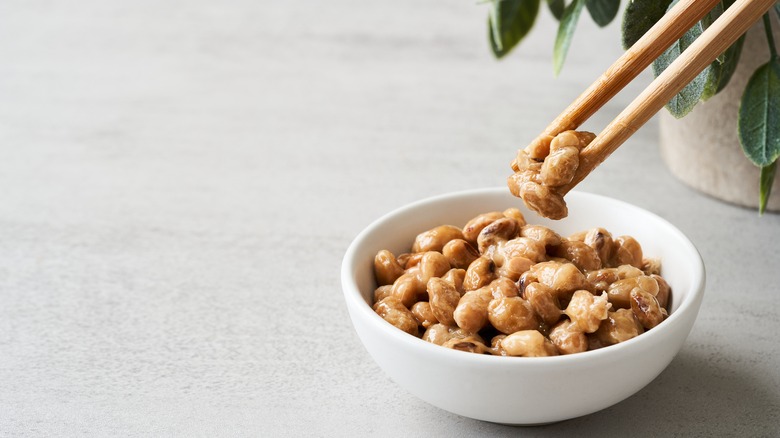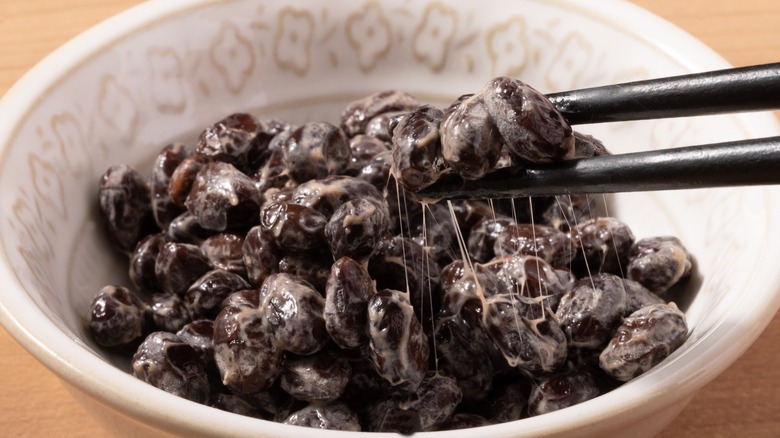What Is Natto And What Does It Taste Like?
Natto, the Japanese fermented soybean, may just be the most important food you have never heard of. Its distinctive pungent smell and strong flavor have divided opinion in Japan for years, meaning it has not gained the worldwide popularity of other fermented foods such as tempeh and kimchi.
However, this controversial dish is packed full of nutrition and has even been described as the healthiest food on the planet, meaning it surely deserves some attention from the rest of the world. Given that the life expectancy in Japan is greater than that in most other countries, trying a superfood that is popular there might not be a bad idea.
Join us as we explore in detail what natto is, how it tastes, and where you can get your hands on some if you want to take the plunge. If you're curious about what causes its strange, stringy texture or how you can make some natto yourself at home, keep reading. Whether you want to get a hold of this unusual superfood for its range of health benefits or just want to see what all the fuss is about, whatever questions you have about natto, you'll find the answers here.
What is natto?
During the past decade or so, fermented foods have been enjoying their deserved place in the spotlight as their health benefits become more widely understood — their probiotic benefits helping them to stand out ahead of other foods. Kimchi, sauerkraut, and kefir have all found themselves trending, but natto remains relatively unknown in this part of the world.
Originating in Japan, natto consists of fermented soybeans, but the fermentation process transforms them into a sticky (though some may say slimy) and flavorsome dish that barely resembles the original beans. It is often enjoyed as a hearty breakfast dish in Japan and is a superb plant-based option that is packed with protein (and we all know it's a common vegan question to ask about protein).
The reason natto has evaded the fermented food obsession in the U.S. may potentially be due to its visual appeal, or should we say, lack of one. Snapping an Insta-worthy pic of natto may prove challenging, as the sticky web-like substance that covers it can be a bit un-photogenic. However, the gooey substance enveloping the natto, known in Japan as neba neba, is an indication of the quantity of gut-friendly bacteria in the dish – more slime means a healthier plate of food. Although natto may seem like an obscure Japanese food to us now, its health benefits and the current upward trend for plant-based food mean it may yet find its popularity growing here in the States.
How is natto made?
To take natto from soybeans, which most of us are familiar with, to the sticky, pungent finished dish, fermentation has to take place. The soybeans are soaked in water, usually overnight, which allows them to absorb water (meaning they will cook more evenly). The beans are then steamed until tender, and traditionally, they would then be wrapped in rice straw, which is a source of the important bacterium Bacillus subtilis natto.
However, in the modern, larger production process, they are sprayed with the bacterium and left for around 24 hours at 104 degrees Fahrenheit. If you want to do this at home, you can buy starter kits that contain the Bacillus subtilis bacteria to get the fermentation underway.
Though the natto is ready to eat after the first day, keeping it refrigerated for up to a week will increase the sticky and stringy nature of the dish, which natto aficionados will prefer. The fermentation process begins to break down the proteins and fats in the soybeans and produces important substances, including vitamin K2, vitamin B6, and vitamin B2. The fermentation process is key to the production of natto, creating the distinctive tangy flavor that divides people, as well as so many beneficial compounds.
Natto vs tempeh
To look at natto and tempeh, you wouldn't guess they were made from the same original ingredient, but the humble soybean is responsible for both. They are both fermented during preparation but with different bacteria — bacillus subtilis for natto and Rhizopus oligosporus for tempeh — and this important difference influences the final outcome, both in terms of flavor and texture. Some store-bought versions of tempeh may also contain grains such as quinoa or rice.
It is the difference in bacteria that contributes to the significantly contrasting flavors of the two soybean products. Natto has a strong, pungent flavor that is very much an acquired taste, with many people disliking its distinctive tang. Tempeh, on the other hand, has a milder nutty taste and takes on other flavors, such as sauce and spices, making it more palatable for many people. It has a firm texture and can be sliced like cake, whereas natto has a slimy texture due to the sticky strings between the beans.
Nutritionally, natto and tempeh are both rich in protein and vitamins. Tempeh is higher in folate, whereas natto is particularly rich in potassium, iron, and calcium. Both tempeh and natto are excellent choices for vegetarians looking for high-protein meat substitutes or those wishing to add some plant-based goodness to their diet.
What does natto taste like?
The answer to "What does natto taste like?" will change depending on who you ask. Lovers of the dish will describe it as delightfully savory, tangy, and salty, perhaps similar to how we would describe a very strong blue cheese. Those in the hating camp, however, are put off by the overpowering smell before they even get to the pungent taste.
Natto is very much the Marmite of Japanese cuisine, with just as many people hating it as loving it. This is not helped by the texture, which definitely takes some getting used to. The fermentation of the soybeans causes the formation of a compound called poly-gamma-glutamate (PGA), which causes the slimy nature of natto. Even if you can get past the acrid scent, finding the mouthfeel of the dish pleasant is unlikely for a first-timer.
As you familiarize yourself with the taste of natto, its earthy umami notes will start to emerge, and a complex flavor profile will unfold, which may prove why so many Japanese people love it. Some have even described it as an earthy bacon flavor. Isn't that the dream for many of us — plants that taste of bacon?
For those willing to step outside their culinary comfort zone, natto can reap rewards for your tastebuds, but probably not on the first attempt. Much like blue cheese or olives, repeated sampling will take this Japanese superfood from an intense, off-putting flavor to a treasured hit of umami goodness.
How to cook with natto
Now that you've decided to accept the culinary mission of trying out some natto for yourself, it's time to work out how best to eat it. If you are buying it from a store, it will likely be packed alongside some soy sauce and Japanese mustard, which will both enhance the flavor of the natto once added.
However, the Japanese have a slightly strange-sounding tradition before you add any seasoning to the dish. Using chopsticks, it is standard practice to stir the natto; not once or twice, but hundreds of times!
The reason for the intense stirring is to bring out the stringy texture of the natto — the more you stir, the more you will create the web of PGA that gives it such a distinctive look and texture. Beyond stirring, it is best not to mess with the natural state of natto too much. A great deal of the health benefits come from the bacteria, and heating the dish above 108 degrees Fahrenheit will destroy them. Instead, serve your natto cold, alongside whatever food you wish.
In Japan, it is often served for breakfast on top of a bowl of rice. The high protein content of the beans means it will be a filling dish no matter what you serve it with, but fish or meat would complement it perfectly too.
Where to buy natto
Unlike similar fermented foods like tempeh and miso — and perhaps one thing you didn't know about kombucha is that it's also fermented – natto is not as widely available, and you may not find it in your local grocery store. However, its popularity is starting to pick up outside of Japan, so if you have a specialty Asian store nearby, it is worth popping in, as they will likely have some.
Failing that, there are now a number of online companies that offer home delivery on natto and deliver nationwide. Sankyodai in New York, Aya's Culture Kitchen in Massachusetts, and online grocer Weee! can all deliver the fermented treat right to your door. As well as the convenience of being able to receive a delivery wherever you are in the States, these companies also allow you to access various natto options and other Japanese delicacies to pair with it.
If you're feeling adventurous, why not make your own natto at home using a natto starter kit? Sold by various online stores, including Amazon, the kit includes the bacteria needed to ferment the soybeans, meaning you can easily whip up a batch at home. Be sure to buy high-quality soybeans, ideally organic, that haven't been genetically modified to ensure you get the most authentic Japanese experience. Making homemade natto will give you a sense of accomplishment and allow you to customize the fermentation to your needs. Remember: Longer fermentation leads to a more stringy texture.
Nutritional profile of natto
In spite of its divisive flavor, natto is eaten widely in Japan and is now beginning to see a growth in popularity elsewhere in the world. This is likely due to the significant health benefits of eating this fermented soybean dish. On so many levels, natto is full of nutrition, meaning it is worth considering adding it to your diet even if you are not totally sold on the flavor yet.
Soybeans themselves are a wonderful plant-based option for both vegetarians and meat-eaters. They are a complete protein, containing all nine essential amino acids; one of the few plant products to do so. They are packed with antioxidants and phytonutrients, some of which are thought to reduce the risk of certain cancers.
In addition to the many health benefits of soybeans, the fermentation process creates further nutritional advantages for natto. As with all fermented foods, it is rich in probiotics, which are brilliant for gut health. Research is now showing that our gut health is even more critical to our overall well-being than we thought, with up to 80% of our immune cells being found there. Balancing your microbiome is a crucial step in improving your gut health, and natto can play a part in that.
Though the word superfood is often overused, natto has earned the title with its vast array of health benefits. If you're on the fence over whether to give it a shot, just go for it.
Varieties of natto
Once you have decided to take the plunge and add natto to your list of new foods to try, you will have to navigate the different types of natto that are available. There are three main types, made by using three different forms of soybean, so if you are planning to make natto yourself, it is worth considering which type of bean to buy.
Kotsubu natto is made from small soybeans and is the most common type of natto you are likely to come across. The larger surface area of the small beans means that more sticky goodness will form, giving the distinctive texture of natto. Otsubu natto is made from larger soybeans, making the overall dish a bit more bean-y than kotsubu. There will be less of the signature stringiness and a milder flavor overall, meaning this variety may better suit those trying it for the first time.
Hikiwari natto is made from crushed soybeans, which gives the natto a smoother texture than the other varieties. The soybeans are split or crushed before fermentation takes place. This version of natto is often used in sushi rolls and salads. Though the vast majority of natto is made from soybeans, other beans can be used, including black beans. They can also be successfully fermented using Bacillus subtilis natto, creating the sticky effect and the same nutritional benefits.
How to store natto
If you've gone to all the effort of making yourself some natto at home, the last thing you want is for it to go off because you haven't stored it correctly. Because of the active cultures contained in natto, it takes a little more care to keep it at its best.
Natto should be kept in the fridge wherever possible. Refrigerating will not only keep it fresh, but it will also slow down any further fermentation, reducing the chances of the natto getting stronger in flavor. You should be able to keep it in the fridge for at least a week, and it will retain its flavor and quality.
If you have made a large batch of natto and need to store it longer term, it is perfectly fine to freeze it. The lower temperature will slow down the fermentation process and preserve the nutrition of your natto. To protect it, transfer it to an airtight box or seal it in a bag before freezing. Make sure to thaw it fully before eating or cooking. These storage tips apply both to homemade natto and store-bought, ensuring you can keep your fermented soybeans at their peak quality for as long as possible.










